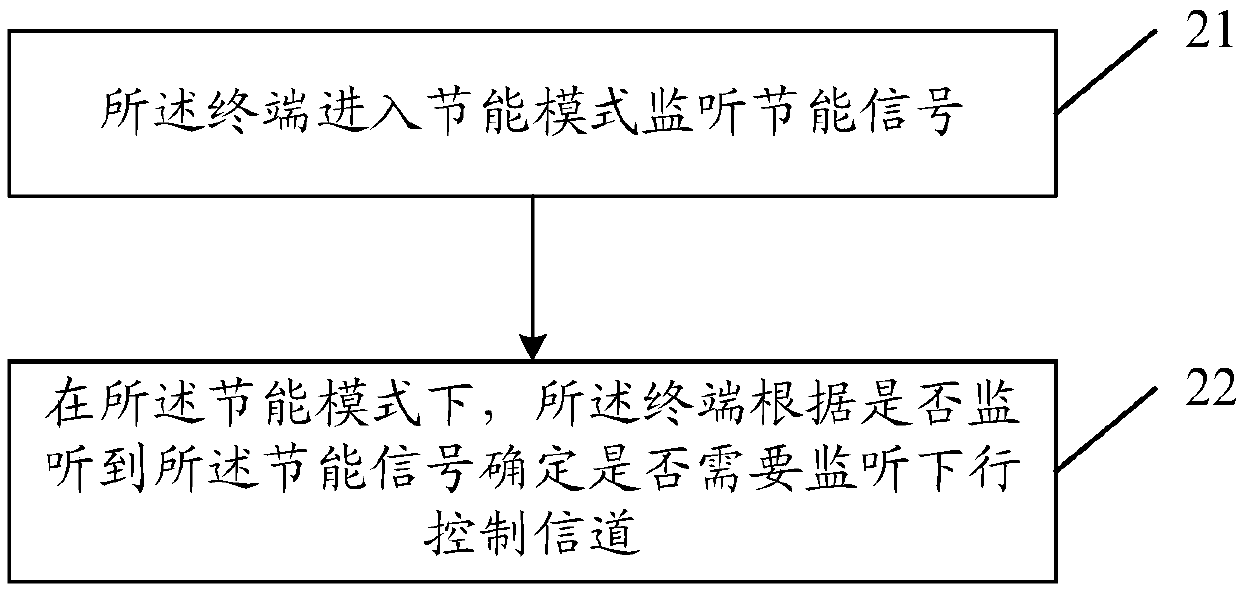Channel monitoring and energy-saving signal processing method and device, terminal and network side equipment
A network-side device and signal technology, applied in the field of communications, can solve problems such as waste of power consumption
- Summary
- Abstract
- Description
- Claims
- Application Information
AI Technical Summary
Problems solved by technology
Method used
Image
Examples
example 1
[0157] Step 1. The network side device notifies the terminal to enter the energy-saving mode and start monitoring the energy-saving signal through network signaling; the network signaling can be high-layer RRC signaling, or bottom-layer MAC CE or PDCCH commands.
[0158] Preferably, the network side device sends the network signaling to the terminal when there is no downlink data transmission;
[0159] Alternatively, the network side device sends the network signaling to the terminal after receiving the request signaling that the terminal requests to enter the energy-saving mode;
[0160] Or, after the network-side device determines that the terminal enters the energy-saving mode, it sends the network signaling to the terminal;
[0161] Or, when the terminal does not have delay-sensitive services, the network side device sends the network signaling to the terminal after determining that the terminal enters the energy-saving mode.
[0162] Step 2: After receiving the network s...
example 2
[0169] Step 3: The terminal and the network side configure the energy-saving timer according to the energy-saving timer configured on the network side or according to the energy-saving timer specified in the protocol, start the energy-saving timer, and restart the timer when there is data transmission.
[0170] Step 4, when the energy-saving timer expires, the terminal starts to monitor the energy-saving signal according to the configuration parameters of the energy-saving signal. After the energy-saving timer expires, the network-side device wakes up the terminal by sending an energy-saving signal to notify the terminal to receive data, instead of directly sending the PDCCH.
[0171] As a preferred embodiment, step 21 includes:
[0172] Determine the configuration parameters of the energy-saving signal according to the network side configuration and / or agreement;
[0173] The terminal enters the energy-saving mode and periodically monitors or continuously monitors the energy...
example 3
[0181] Step 5, the terminal periodically monitors the energy-saving signal (the network or protocol configures the terminal to periodically monitor the energy-saving signal), and when the terminal detects its own energy-saving signal for wake-up, it wakes up and continues to monitor whether there is PDCCH scheduling, otherwise the terminal will continue to save energy. mode, monitor the energy-saving signal at the sending time of the next energy-saving signal.
[0182] Step 6: When the network has data to send to the terminal, it first sends an energy-saving signal to wake up the terminal according to the cycle of sending the energy-saving signal, notifying the terminal that it needs to wake up to receive data, and then sends a PDCCH signal to schedule data transmission. Otherwise, the network does not send an energy-saving signal to wake up the terminal when the energy-saving signal is sent, but sends a sleep energy-saving signal to notify the terminal to continue to enter the...
PUM
 Login to View More
Login to View More Abstract
Description
Claims
Application Information
 Login to View More
Login to View More - R&D Engineer
- R&D Manager
- IP Professional
- Industry Leading Data Capabilities
- Powerful AI technology
- Patent DNA Extraction
Browse by: Latest US Patents, China's latest patents, Technical Efficacy Thesaurus, Application Domain, Technology Topic, Popular Technical Reports.
© 2024 PatSnap. All rights reserved.Legal|Privacy policy|Modern Slavery Act Transparency Statement|Sitemap|About US| Contact US: help@patsnap.com










